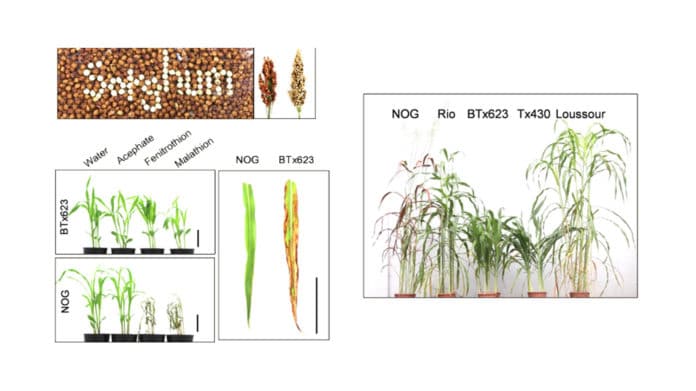Due to its nutrient-dense and gluten-free nature, Sorghum is considered a superfood. Its syrup is widely used as an alternative to molasses in the food industry.
Besides being an effective renewable source of biofuel and chemicals, Sorghum is also a high-quality animal fodder.
Improving the cultivation of Sorghum is essential for continuing to reap the benefits of this cereal and for leveraging its economic advantages. However, Sorghum—like other crops—has some undesirable traits that reduce its yield. One such trait is sensitivity to organophosphates, which are commonly used pesticides.
Organophosphates turn Sorghum leaves brown, causing cell death and wilting.
Scientists from the Okayama University, Japan, recently identified the genes responsible for leaf browning after Orgonophospates treatment. They identified cellular mechanisms that cause organophosphate sensitivity (OPS) in sorghum plants.
They found that the genes encoding the NB-LRR protein are responsible for OPS in Sorghum. The mechanism of organophosphate-induced damage in Sorghum was similar to how plants suffer damage during pathogenic infections.
Prof. Wataru Sakamoto—who has been studying the genes controlling “leaf greenness” for over ten years and led this research—comments, “Sorghum has many benefits. It is also interesting from a research standpoint because of its high tolerance against drought and harsh environments, its small genome size, and its genetic similarity to rice. Further describing what prompted this investigation. If a gene causes an undesirable trait in plants, removing or inactivating the gene could help eliminate the negative trait. We saw that a Japanese variety of Sorghum called Takakibi exhibited leaf browning after pesticide treatment during our research. So, we set out to understand the genetic cause of pesticide sensitivity in this plant.”
For this study, scientists started with crossing (i.e., mating) the organophosphate-sensitive Takakibi (or NOG) with the organophosphate-resistant sorghum variety BTx623. They found that all the progeny showed OPS. This implied that OPS was a “dominant” trait. It means that plants would be sensitive to organophosphates even if they had one copy of an OPS-related gene.
Which genes cause OPS in Sorghum?
To identify those genes, scientists used a technique called ‘Quantitative trait locus mapping.’ Using this technique, they identified the genetic locations associated with OPS in the NOG variety.
A region on chromosome 5 was found to be associated with OPS in NOG. Further study revealed the presence of three genes in this region. These genes encode an NB-LRR protein, which is present on the outer membrane of plant cells and recognizes external agents, including pathogens.
They concluded that the NLR-C gene—which was functional in NOG but not in BTx623—was responsible for OPS in a dominant manner.
Prof. Sakamoto commented, “Pesticides like organophosphates are very useful in protecting plants from insects, but they should not damage the plant itself. Our findings could help develop sorghum varieties that can be grown safely with organophosphate treatment, thus improving the longevity of this crop. Moreover, this OPS trait is not specific to Sorghum but can also be observed in other important plants, including tomatoes. Our findings could therefore help in the development of sustainable agriculture with the proper use of pesticides.”
The study could offer an improved understanding of the diverse roles played by the NB-LRR protein in Sorghum. But more importantly, it lays the foundation for much-needed improvements in the breeding of Sorghum.
Journal Reference:
- Jing, Z., Wacera W., F., Takami, T. et al. NB-LRR-encoding genes conferring susceptibility to organophosphate pesticides in Sorghum. Sci Rep 11, 19828 (2021). DOI: 10.1038/s41598-021-98908-7
